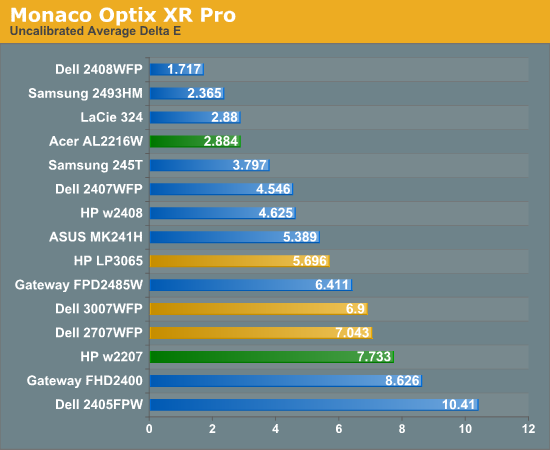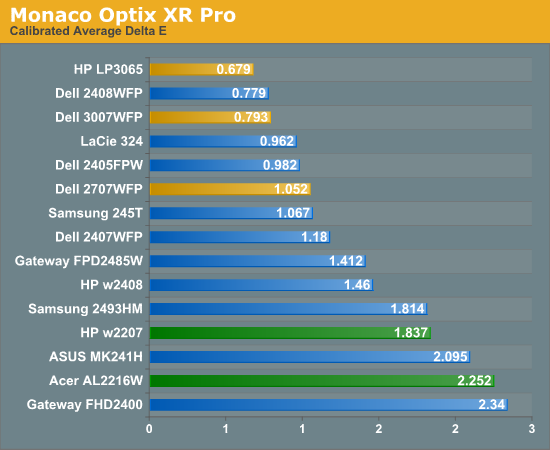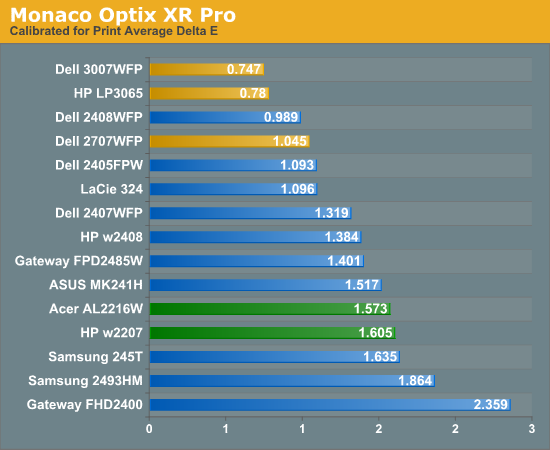Color Accuracy
Imaging professionals definitely like to have accurate colors, and the best way of assuring that your display shows the proper colors is to use a colorimeter and calibration software. However, not everyone has access to such tools and many users are unwilling to spend over $200, so we test before and after calibration. (Put more accurately, we calibrate the monitors and then tweak the created profile back to an uncalibrated state so that we can evaluate the performance of the display in its default state.) For calibration, we target a white level of 250 nits -- anything more than that is too bright in our opinion. We also do a second calibration targeting a white level of 100 nits, which would be useful when working on material that will end up in print form. Before we get the results, here are the display settings we used on the test LCDs. We let the LCDs stabilized for at least one hour before performing measurements.
| LCD Brightness and Contrast Settings | ||
| Standard Calibrated (~250 nits) | Calibrated for Print (~100 nits) | |
| ASUS MK241H | 45 Brightness, 80 Contrast 100-100-100 RGB |
50 Brightness, 80 Contrast 54-51-73 RGB |
| Dell 2408WFP | 50 Brightness, 50 Contrast 80-80-80 RGB |
48 Brightness, 50 Contrast 55-55-55 RGB |
| Gateway FHD2400 | 70 Brightness, 70 Contrast 76-77-92 RGB |
50 Brightness, 50 Contrast 57-57-70 RGB |
| LaCie 324 | 35 Brightness, 0 Contrast 128-128-128 RGB 2.2 Gamma, 6500K |
7 Brightness, 0 Contrast 128-128-128 RGB 2.2 Gamma, 6500K |
| Samsung 2493HM | 60 Brightness, 75 Contrast 100-100-100 RGB |
28 Brightness, 75 Contrast 46-37-65 RGB |



Starting with the uncalibrated results, it's pretty easy to see why we feel calibration tools are necessary for most users. This is not to say that you can't be happy with inaccurate colors -- your eyes will compensate, and some people prefer warmer (redder) or cooler (bluer) tones. However, if you're doing work with images or video as an example, it is important that what you see on your display matches as much as possible what others will see on their displays. Of the tested LCDs, only four are able to achieve an average Delta E of less than 3.0 without calibration -- three of which happen are part of this roundup. That's encouraging, as it indicates LCD manufacturers may be spending a bit of extra time to ensure that at least one of the settings will provide neutral, accurate colors. The real shocker however is the Dell 2408WFP. Its uncalibrated Delta E reaches an exceptional 1.7 -- a score that's better than several of the LCDs after calibration!
With calibration, all the scores improve substantially, but anyone serious about color accuracy is probably going to want an average Delta E of around 1.0 or less after calibration. Of the tested monitors, the 24" Dell displays (all three models that we've tested), the LaCie 324, and the two 30" LCDs all manage to accomplish this, along with the Dell 2707WFP and Samsung 245T. Switching to appropriate "printing" settings puts the three largest LCDs at the top of the charts, along with the Dell 2408WFP (and the old 2405FPW) and LaCie 324.
Most of the LCDs in this roundup place in the middle or upper portion of the above graphs, with one exception. The Gateway FHD2400 comes in last or in second to last in all three tests. We actually really like the Gateway display for many of its features, but in terms of color accuracy it is definitely lacking. We spent a substantial amount of time trying to tweak the settings in order to achieve better results, all to no avail. There's more to LCDs than color accuracy, of course, and the price and appearance might be enough to help you overlook the relatively poor performance here.










89 Comments
View All Comments
Rasterman - Friday, May 9, 2008 - link
Yeah the figures reported are meaningless, if they were actually useful we wouldn't even need reviews :) I can't believe that a company as big as Viewsonic doesn't send a review site as big as Anandtech a review model, that is just ridiculous, they should be sending you guys a new model of every new monitor without even asking, maybe you aren't emailing the right person. BTW its awesome to see a reviewer actually answer questions and critics to a review, awesome job Jarred!JarredWalton - Friday, May 9, 2008 - link
I'm sure I'm not getting the right person at Viewsonic (and other companies as well), but that's the trick: *finding* the right person. Without an inside contact, it can be tough to get started.Generic PR Person: "AnandTech? What kind of a name is that? http://www.homestarrunner.com/sbemail50.html">Baleeted!" I'll try to meet with them next CES or something....
PS - Anyone from Viewsonic read this? If so, email me! :-)
10e - Tuesday, May 6, 2008 - link
Great review. This is what multifunction fans are looking for. I had this issue a year ago trying to find "THE" multifunction.You may want to mention that in terms of 720p and 1080p the Samsung stretches both to 16:10 with A/V mode off. I tested this and found that problem recently, which was unfortunate due to the fact that I liked it as a high quality TN.
JarredWalton - Tuesday, May 6, 2008 - link
I mentioned this on page 11, but I have highlighted (italicized) the pertinent text. I also clarified by indicating that 16:9 modes will always have the wrong AR. Thanks for reading and commenting!xerces8 - Monday, May 5, 2008 - link
A picture says more than 1000 words :http://www.digitalversus.com/duels.php?ty=6&ma...">http://www.digitalversus.com/duels.php?...2=49&...
(I can't create a link, seems the post javascript is broken, I cant make bold or italics text either, tried FF and IE7)
JarredWalton - Monday, May 5, 2008 - link
You mean, http://www.digitalversus.com/duels.php?ty=6&ma...">pictures like this one? I don't see any large blowups of their comparisons available for download, so I have no idea exactly how they're testing. What I do know is that I provided images showing LaCie 324 and Dell 2408WFP clearly displaying a 40ms delay relative to an HP LP3065, and I've also provided a picture of the ASUS MK241H with a relative delay of 0ms relative to the same LCD.I've got nine other sample images from each of the tested monitors showing the evidence for my "input lag" conclusions. That's about as close to full disclosure as you'll get. All I get on that comparison you linked is a chart that apparently "proves" the ASUS MK241H has a 54ms average delay compared to a CRT, but then the same site lists the Dell 2408WFP as 69ms, the 2407WFP as 24ms, the LaCie as 41ms, and the Samsung 245T at 59ms. I got more or less the same result on the Dell 2407WFP and the LaCie 324, but nowhere near the same result on the MK241H, 2408WFP, and the 2493HM.
Again, you've got at least one clear sample of my results for each LCD. Sorry, but I have to question their results without better evidence.
Dashel - Monday, May 5, 2008 - link
Hi Jarred,Not sure if this is based on the same test or what but there is this:
http://www.behardware.com/art/imprimer/712/">http://www.behardware.com/art/imprimer/712/
Which looks to be the same graph and results. To me your results seem to make the most sense if the 2408 is very similar to the 2407WFP-HC, then the input lag should be close too I would guess. I'm hardly an expert just tryint to be logical.
The thing is I also see anecdotal claims of lag and people who have tested it getting in the 60ms range as well which leads me to wonder if there isnt some sort of defect or difference in some of the panels vrs others.
Example of a test by an owner:
http://www.hardforum.com/showpost.php?p=1032124531...">http://www.hardforum.com/showpost.php?p=1032124531...
I'd love to hear Dells thoughts on it as well as what and when their revision is due to hit.
JarredWalton - Monday, May 5, 2008 - link
I'd like to know what software people are using as timers. I tried about 10 different "timers" and discovered that a bunch are limited to the Windows default timing resolution - about 54ms. So they either scored "0ms" or "54ms" on the delay. I know this because I had screen refreshes where the timer was split in half; the top half would show for example 40.067 and the bottom would show 50.121.3DMark03 at least looks to be accurate down to 10ms - there are again pictures where the timer is cut in half, only in such cases I would see 20.23 and 20.24, so I can be sure that the timer is updated in .01s increments rather than in something larger.
Without a lot more details about what software people use and large images showing the results, I must say that I'm very skeptical. I feel "input lag" testing needs several things to be even remotely acceptable:
1) Run at native LCD resolution in clone mode (because built-in scalers could have an impact)
2) Disclosure of the test software that manages better than 54ms accuracy.
3) You need a high-end camera with a fast shutter speed to capture the results. Simply choosing "Auto" mode and snapping a picture doesn't tell the whole story.
4) Provide at least one sample image at a high resolution that clearly shows what the camera captured.
I met all of those criteria I think. In looking around at other reviews, I have not been able to clearly answer any of those questions. Perhaps that's why some of the other results are so different. I also tested at 2560x1600 to verify that I wasn't hurting the HP LP3065 by running at a lower resolution; since the scaling is handled by the GPU rather than the LCD (the LP3065 doesn't have a scaler), there was no penalty.
DangerousQ - Monday, May 5, 2008 - link
I cant believe this set of reviews is so one sided, why no P-MVA panels, I bought a BenQ FP241W about 3 monyths ago and the 6ms response time plus unbelievable colours make this panel really hard to beat, but you try finding any reviews on it. The one review I did find, a long time ago and have lost it now compared it to the 2407 dell and found it a better panel for less money! I know this cos I was going to buy the dell before I saw the review.JarredWalton - Monday, May 5, 2008 - link
Send me an MVA panel - or get one of the manufacturers to send me one - and I will be more than happy to review it. I don't have the means to go out and purchase $500+ test LCDs, so I review what I get sent. Dell, Gateway, Samsung, ASUS, and other major companies are great about working with review sites like ours. Other companies are not. Thus, I take what I can get.